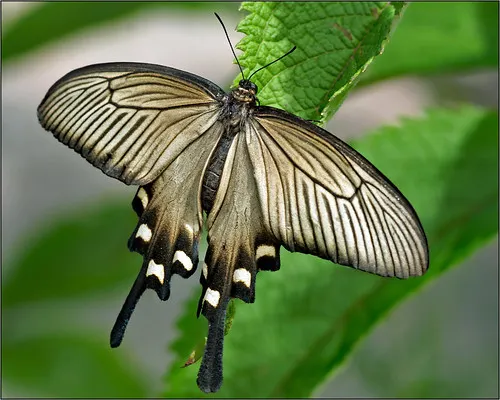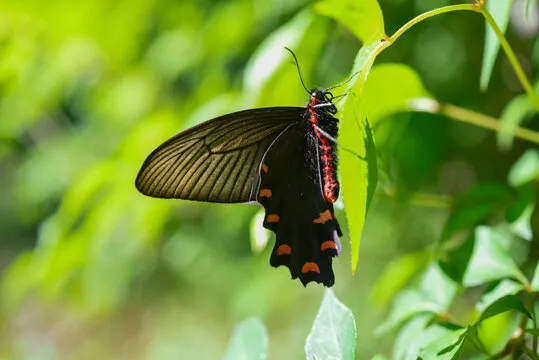Facts about Byasa Alcinous Butterfly

The Byasa alcinous, commonly known as the Chinese Windmill or Alcinous Windmill, is a striking butterfly species admired for its graceful flight and exotic beauty. Belonging to the family Papilionidae (swallowtail butterflies), this rare and visually captivating insect plays a vital role in its ecosystem while also holding cultural significance in parts of Asia. Found primarily across East and Southeast Asia, it enchants both butterfly enthusiasts and entomologists with its unique coloration, behavior, and life cycle.
This in-depth article explores the Byasa alcinous butterfly’s appearance, distribution, life stages, ecological importance, and conservation concerns.
🦋 Appearance: Beauty in Black and Red
The Byasa alcinous is easily recognizable due to its velvety black wings, soft white or cream-colored spots, and bright red crescents on the hindwings. It has:
- A wingspan ranging from 90–110 mm
- Long, elegant tails extending from the hindwings, characteristic of swallowtails
- A slender black body with fine red markings
- Males and females are similar, but females may be slightly larger
These vivid markings serve not just for beauty but also as a warning to predators—the butterfly contains toxic alkaloids it absorbs from its host plants.
🌏 Habitat & Distribution
Byasa alcinous can be found in:
- China
- Taiwan
- Japan
- Korea
- Parts of Vietnam and Laos
It inhabits forested areas, woodland edges, and low to mid-elevation mountain regions where host plants grow. It prefers warm, humid climates and is most active in spring and early summer.
🌿 Host Plants and Larval Diet
The survival of the Chinese Windmill heavily depends on plants from the Aristolochiaceae family, especially:
- Aristolochia debilis
- Aristolochia manchuriensis
- Aristolochia kaempferi
These plants contain aristolochic acids, which are toxic to many animals. However, the larvae of Byasa alcinous have evolved to feed exclusively on them, gaining a chemical defense that protects both larvae and adults from predators like birds and lizards.

🐛 Life Cycle: From Egg to Butterfly
Like all butterflies, Byasa alcinous goes through a complete metamorphosis:
- Egg
- Small, round, and cream-colored
- Laid singly on host plant leaves
- Larva (Caterpillar)
- Brownish-black with rows of orange or red tubercles
- Feeds exclusively on Aristolochia species
- Emits unpleasant chemical odors when threatened
- Pupa (Chrysalis)
- Attached upright to twigs or stems
- Camouflaged to resemble dead leaves or twigs
- Adult Butterfly
- Emerges with fully formed wings
- Lives for 1–2 weeks, feeding on flower nectar
🧬 Defense and Mimicry
Byasa alcinous employs aposematism (warning coloration) and chemical defense as survival strategies. Its resemblance to other unpalatable butterflies such as Atrophaneura species is an example of Müllerian mimicry, where multiple toxic species evolve similar appearances to reinforce predator avoidance.
🌸 Behavior and Flight
- Slow and floating flight – Unlike fast-flying butterflies, it glides gently through the air, giving it a majestic presence.
- Nectar feeding – Adults are drawn to flowers such as azaleas, thistles, and milkweed.
- Territoriality – Males often patrol areas and may engage in aerial displays to defend territories or attract mates.
🔬 Taxonomy and Subspecies
- Scientific name: Byasa alcinous (formerly Atrophaneura alcinous)
- Family: Papilionidae
- Subspecies: Multiple subspecies exist, adapted to specific regions:
- B. a. alcinous – Found in Japan
- B. a. yakushimana – Yakushima Island
- B. a. confusus – Korea and China
Each may differ slightly in wing shape, size, or color intensity.
🛡️ Conservation Status
While not currently listed as endangered globally, localized threats exist:
- Habitat loss due to deforestation and urban expansion
- Decline of Aristolochia plants from land-use changes
- Climate change, which affects breeding cycles and plant availability
Some regions have protected areas or butterfly sanctuaries where Byasa alcinous and its host plants are monitored and preserved.
🏮 Cultural Significance
In Japanese and Chinese art, butterflies often symbolize transformation, elegance, and the soul. The Byasa alcinous, with its graceful flight and delicate features, often appears in traditional paintings and poetry as a symbol of ephemeral beauty.
📌 Quick Facts Table
| Feature | Description |
|---|---|
| Scientific Name | Byasa alcinous |
| Common Name | Chinese Windmill Butterfly |
| Family | Papilionidae |
| Wingspan | 90–110 mm |
| Habitat | Forests and wooded mountains |
| Host Plants | Aristolochia species |
| Defense Mechanism | Toxic chemicals, warning coloration |
| Flight Style | Graceful, slow-gliding |
| Distribution | East & Southeast Asia |

🌿 Final Thoughts
The Byasa alcinous butterfly is more than just a symbol of grace—it is a living example of evolutionary adaptation, chemical defense, and ecological interdependence. Its reliance on toxic host plants, coupled with its unique visual signals, makes it a fascinating subject for both scientific study and cultural admiration.
As with many species, protecting its habitat and host plants is crucial to ensuring that future generations can witness the elegance of this butterfly gliding gently through the forest air.



